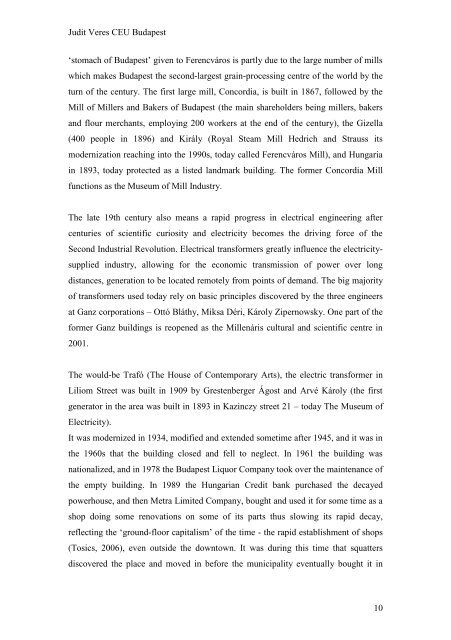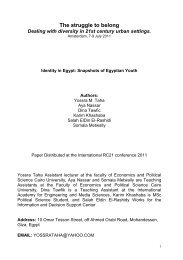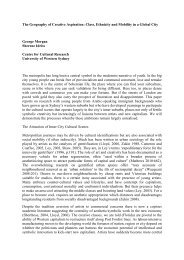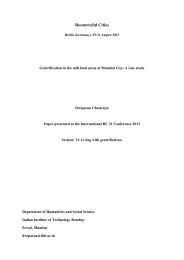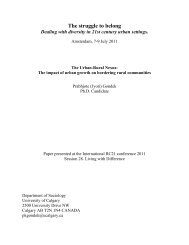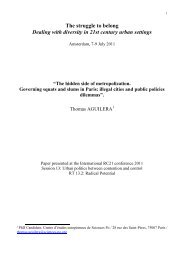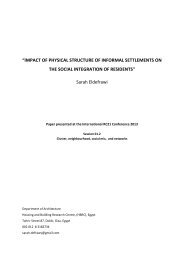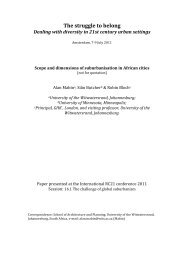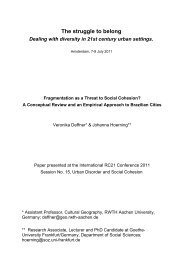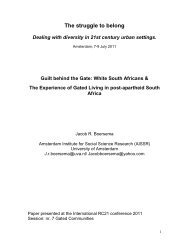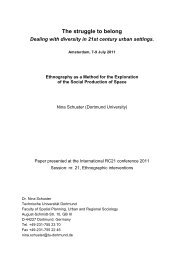Gentrification as a broad process of reurbanization - RC21 ORG ...
Gentrification as a broad process of reurbanization - RC21 ORG ...
Gentrification as a broad process of reurbanization - RC21 ORG ...
Create successful ePaper yourself
Turn your PDF publications into a flip-book with our unique Google optimized e-Paper software.
Judit Veres CEU Budapest<br />
‗stomach <strong>of</strong> Budapest‘ given to Ferencváros is partly due to the large number <strong>of</strong> mills<br />
which makes Budapest the second-largest grain-<strong>process</strong>ing centre <strong>of</strong> the world by the<br />
turn <strong>of</strong> the century. The first large mill, Concordia, is built in 1867, followed by the<br />
Mill <strong>of</strong> Millers and Bakers <strong>of</strong> Budapest (the main shareholders being millers, bakers<br />
and flour merchants, employing 200 workers at the end <strong>of</strong> the century), the Gizella<br />
(400 people in 1896) and Király (Royal Steam Mill Hedrich and Strauss its<br />
modernization reaching into the 1990s, today called Ferencváros Mill), and Hungaria<br />
in 1893, today protected <strong>as</strong> a listed landmark building. The former Concordia Mill<br />
functions <strong>as</strong> the Museum <strong>of</strong> Mill Industry.<br />
The late 19th century also means a rapid progress in electrical engineering after<br />
centuries <strong>of</strong> scientific curiosity and electricity becomes the driving force <strong>of</strong> the<br />
Second Industrial Revolution. Electrical transformers greatly influence the electricitysupplied<br />
industry, allowing for the economic transmission <strong>of</strong> power over long<br />
distances, generation to be located remotely from points <strong>of</strong> demand. The big majority<br />
<strong>of</strong> transformers used today rely on b<strong>as</strong>ic principles discovered by the three engineers<br />
at Ganz corporations – Ottó Bláthy, Miksa Déri, Károly Zipernowsky. One part <strong>of</strong> the<br />
former Ganz buildings is reopened <strong>as</strong> the Millenáris cultural and scientific centre in<br />
2001.<br />
The would-be Trafó (The House <strong>of</strong> Contemporary Arts), the electric transformer in<br />
Liliom Street w<strong>as</strong> built in 1909 by Grestenberger Ágost and Arvé Károly (the first<br />
generator in the area w<strong>as</strong> built in 1893 in Kazinczy street 21 – today The Museum <strong>of</strong><br />
Electricity).<br />
It w<strong>as</strong> modernized in 1934, modified and extended sometime after 1945, and it w<strong>as</strong> in<br />
the 1960s that the building closed and fell to neglect. In 1961 the building w<strong>as</strong><br />
nationalized, and in 1978 the Budapest Liquor Company took over the maintenance <strong>of</strong><br />
the empty building. In 1989 the Hungarian Credit bank purch<strong>as</strong>ed the decayed<br />
powerhouse, and then Metra Limited Company, bought and used it for some time <strong>as</strong> a<br />
shop doing some renovations on some <strong>of</strong> its parts thus slowing its rapid decay,<br />
reflecting the ‗ground-floor capitalism‘ <strong>of</strong> the time - the rapid establishment <strong>of</strong> shops<br />
(Tosics, 2006), even outside the downtown. It w<strong>as</strong> during this time that squatters<br />
discovered the place and moved in before the municipality eventually bought it in<br />
10


